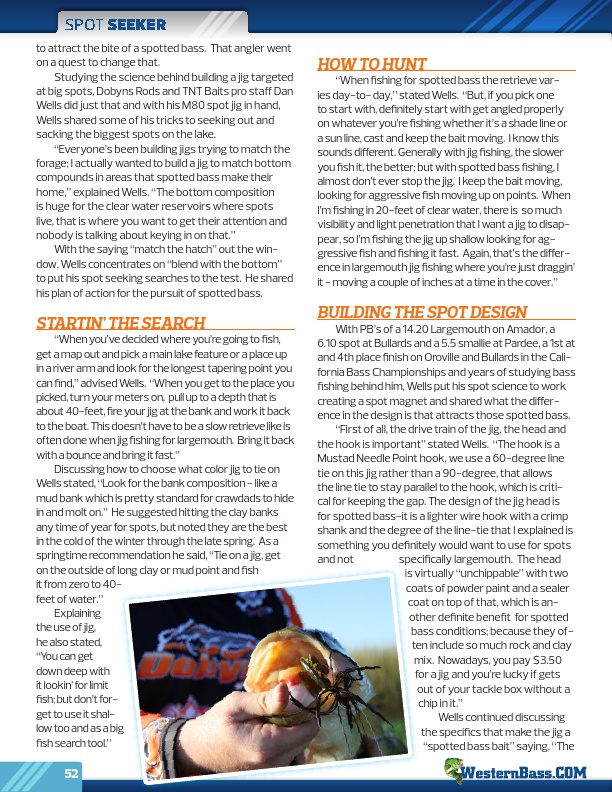
SPot seeker
to attract the bite of a spotted bass. That angler went on a quest to change that. Studying the science behind building a jig targeted at big spots, dobyns rods and tNt Baits pro staff dan Wells did just that and with his M80 spot jig in hand, Wells shared some of his tricks to seeking out and sacking the biggest spots on the lake. “everyone’s been building jigs trying to match the forage; i actually wanted to build a jig to match bottom compounds in areas that spotted bass make their home,” explained Wells. “The bottom composition is huge for the clear water reservoirs where spots live, that is where you want to get their attention and nobody is talking about keying in on that.” With the saying “match the hatch” out the win- dow, Wells concentrates on “blend with the bottom” to put his spot seeking searches to the test. He shared his plan of action for the pursuit of spotted bass.
“When fishing for spotted bass the retrieve var- ies day-to- day,” stated Wells. “But, if you pick one to start with, definitely start with get angled properly on whatever you’re fishing whether it’s a shade line or a sun line, cast and keep the bait moving. i know this sounds different. Generally with jig fishing, the slower you fish it, the better; but with spotted bass fishing, i almost don’t ever stop the jig. i keep the bait moving, looking for aggressive fish moving up on points. When i’m fishing in 20-feet of clear water, there is so much visibility and light penetration that i want a jig to disap- pear, so i’m fishing the jig up shallow looking for ag- gressive fish and fishing it fast. again, that’s the differ- ence in largemouth jig fishing where you’re just draggin’ it - moving a couple of inches at a time in the cover.”
HOW TO HUNT
“When you’ve decided where you’re going to fish, get a map out and pick a main lake feature or a place up in a river arm and look for the longest tapering point you can find,” advised Wells. “When you get to the place you picked, turn your meters on, pull up to a depth that is about 40-feet, fire your jig at the bank and work it back to the boat. This doesn’t have to be a slow retrieve like is often done when jig fishing for largemouth. Bring it back with a bounce and bring it fast.” discussing how to choose what color jig to tie on Wells stated, “look for the bank composition - like a mud bank which is pretty standard for crawdads to hide in and molt on.” He suggested hitting the clay banks any time of year for spots, but noted they are the best in the cold of the winter through the late spring. as a springtime recommendation he said, “tie on a jig, get on the outside of long clay or mud point and fish it from zero to 40- feet of water.” explaining the use of jig, he also stated, “You can get down deep with it lookin’ for limit fish; but don’t for- get to use it shal- low too and as a big fish search tool.”
STARTIN’ THE SEARCH
With PB’s of a 14.20 largemouth on amador, a 6.10 spot at Bullards and a 5.5 smallie at Pardee, a 1st at and 4th place finish on oroville and Bullards in the Cali- fornia Bass Championships and years of studying bass fishing behind him, Wells put his spot science to work creating a spot magnet and shared what the differ- ence in the design is that attracts those spotted bass. “First of all, the drive train of the jig, the head and the hook is important” stated Wells. “The hook is a Mustad Needle Point hook, we use a 60-degree line tie on this jig rather than a 90-degree, that allows the line tie to stay parallel to the hook, which is criti- cal for keeping the gap. The design of the jig head is for spotted bass-it is a lighter wire hook with a crimp shank and the degree of the line-tie that i explained is something you definitely would want to use for spots and not specifically largemouth. The head is virtually “unchippable” with two coats of powder paint and a sealer coat on top of that, which is an- other definite benefit for spotted bass conditions; because they of- ten include so much rock and clay mix. Nowadays, you pay $3.50 for a jig and you’re lucky if gets out of your tackle box without a chip in it.” Wells continued discussing the specifics that make the jig a “spotted bass bait” saying, “The
bUILDING THE SPOT DESIGN
52